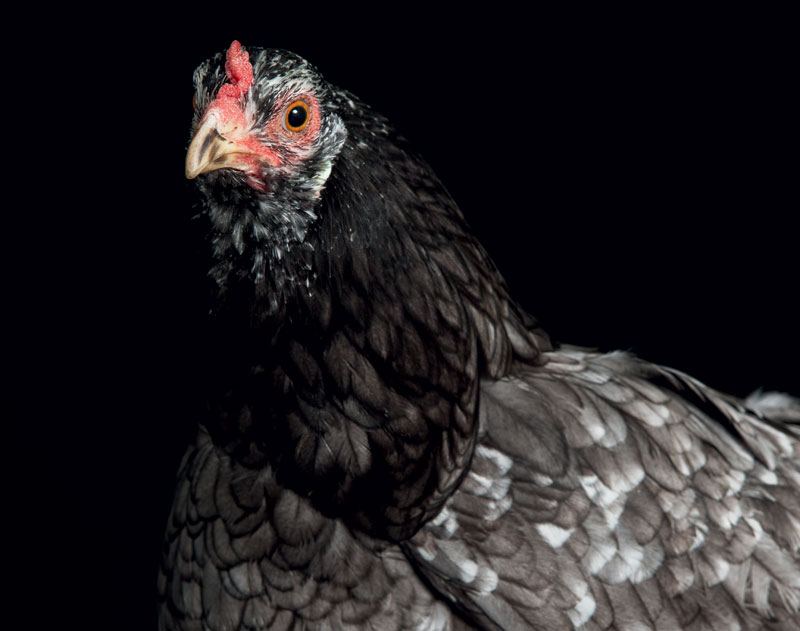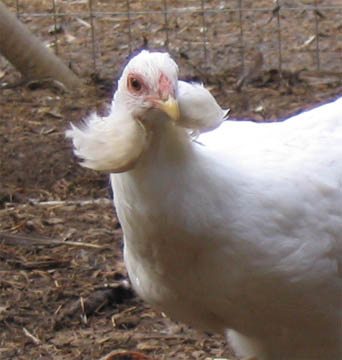The Origin of the Araucana Chicken is a Murky, Fascinating Mystery
Theories place it as the lynchpin of a mass migration across the oceans.
The Origin of the Araucana Chicken is a Murky, Fascinating Mystery
Theories place it as the lynchpin of a mass migration across the oceans.

Of all the chickens in the world, one of the weirdest is the oft-tufted South American breed known as the Araucana. Its origin continues to puzzle scientists.
Every chicken you buy, whether it’s a Cornish game hen from the UK or a black chicken from China, is a domesticated form of the red junglefowl, a bird native to south and southeast Asia that looks basically like a slightly more elaborate chicken. The junglefowl (what a name!) was domesticated at least 5,000 years ago, probably first in China, a process that involved cross-breeding the more docile birds until a new, easier-to-handle species emerged.
Today, there’s a fairly wide variety in chicken breeds (many of which we outline here). They are different sizes, have different colored skin and feathers, make different noises, lay different colored eggs. One of the oddest, in appearance and in its questionable timeline, is the Araucana. The long-held theory, according to most historians, is that this breed was probably first bred by the Mapuche people in Chile. The Araucana lays brilliant blue-turquoise eggs, and sometimes demonstrates these adorable little Civil-War-mutton-chop-like ear tufts. Here, look:

Haha, weird. Anyway, things get weirder, but we have to dive back in time to get a sense of why – all the way back to Spanish explorer Francisco Pizarro’s journey to South America in 1532. Pizarro wasn’t the first European to visit the Pacific coast of South America; he was beaten by a few decades by Diego de Almagro. But here’s the fact that has long baffled historians: There were, according to these accounts, already chickens in South America, integral parts of the lives of the native peoples when Pizarro first arrived in Peru in 1532. Chickens made up a large part of the local Inca diet, and featured heavily in legends and rituals. Historians and anthropologists have long been confused by this – how can something introduced, at most, a couple decades before Pizarro’s arrival have had such a firm hold on a society?
The leap from there comes from that factual confusion. The basic concept: What if the native South Americans had so thoroughly integrated chickens into their society by 1532 because they had actually had chickens for a much longer period? What if they had chickens before any European contact at all?
Historians and anthropologists, with that in mind, have taken a second look at the origin of the Araucana, a strange-enough bird that it seems to make sense that it doesn’t come from Europe, since there’s nothing much like it anywhere in Spain or Portugal. With tufted cheeks, no tail at all, and bright blue eggs, the Araucana is most common just down the coast from Peru, in Chile. The theory is that the Araucana might be a hybrid of European chickens and whatever chickens existed before European contact.
And so we come to the rub: There is a long-standing theory, still basically unproven, that islanders from Polynesia did, at some point, make contact with the Pacific coast of South America, long before the Europeans got there. The Polynesians were certainly explorers before the Europeans found the Americas, making contact with remote islands from New Zealand to Hawaii. But it’s quite a long trip to get from the South Pacific out to Peru. Still, some are convinced they did it – and the Araucana is right at the center of that theory.
In 2007, a scientific paper was published in Proceedings of the National Academy of Sciences of the United States of America stating that it was possible, even likely, that the chickens found in Chile aren’t just a fairly old, fairly isolated Chilean breed of chicken. The study examined the DNA of what’s now known as the El Arenal Chicken Bone (really!), a very old bone found in an archaeological site called El Arenal on the Pacific coast of Chile. This bone was radiocarbon-dated to somewhere between 1321 and 1407, more than a century before Pizarro wrote about the Mapuche and their chickens. Aha, say the scientists: proof! The chicken pre-dates Europeans in South America!
Even better: That 2007 paper found a specific DNA sequence in the El Arenal Chicken Bone that’s shared with samples of chickens from Polynesia. Everyone was very excited about old chickens in 2007; basically every publication with a passing interest in science wrote about it.
(The other main point of reasoning for the pre-European-chickens-in-South-America theory comes from the sweet potato, native to South America, that has been found in the Cook Islands of the South Pacific and radiocarbon-dated to 1000 CE, long before any contact with South America is supposed to have happened. Nobody really knows how the sweet potato got there.)
But in 2008, and then again in 2014, studies came out in the same journal that disputed the findings in the 2007 paper, going deeper into the specific, particular DNA of Polynesian chickens and finding that there is no real connection between the Araucana and Polynesian chickens. The 2014 paper specifically argued that there were some problems with the radiocarbon dating on the El Arenal Chicken Bone, though that has in turn been challenged by a paper, which itself has been challenged.
So what’s the status of the Polynesian-explorer theory now? It is, basically, a mess. There is not scientific consensus on the radiocarbon dating of the El Arenal Chicken Bone, there is not scientific consensus on the DNA connection between the Araucana and Polynesian chickens, and we still know basically nothing about the timeline and specifics of the various waves of discovery that resulted in the peopling of the South Pacific islands.
One thing’s for sure: The Araucana is even more mysterious than it looks.
Follow us
This work is licensed under a Creative Commons Attribution-NoDerivatives 4.0 International License.
Want to republish a Modern Farmer story?
We are happy for Modern Farmer stories to be shared, and encourage you to republish our articles for your audience. When doing so, we ask that you follow these guidelines:
Please credit us and our writers
For the author byline, please use “Author Name, Modern Farmer.” At the top of our stories, if on the web, please include this text and link: “This story was originally published by Modern Farmer.”
Please make sure to include a link back to either our home page or the article URL.
At the bottom of the story, please include the following text:
“Modern Farmer is a nonprofit initiative dedicated to raising awareness and catalyzing action at the intersection of food, agriculture, and society. Read more at <link>Modern Farmer</link>.”
Use our widget
We’d like to be able to track our stories, so we ask that if you republish our content, you do so using our widget (located on the left hand side of the article). The HTML code has a built-in tracker that tells us the data and domain where the story was published, as well as view counts.
Check the image requirements
It’s your responsibility to confirm you're licensed to republish images in our articles. Some images, such as those from commercial providers, don't allow their images to be republished without permission or payment. Copyright terms are generally listed in the image caption and attribution. You are welcome to omit our images or substitute with your own. Charts and interactive graphics follow the same rules.
Don’t change too much. Or, ask us first.
Articles must be republished in their entirety. It’s okay to change references to time (“today” to “yesterday”) or location (“Iowa City, IA” to “here”). But please keep everything else the same.
If you feel strongly that a more material edit needs to be made, get in touch with us at [email protected]. We’re happy to discuss it with the original author, but we must have prior approval for changes before publication.
Special cases
Extracts. You may run the first few lines or paragraphs of the article and then say: “Read the full article at Modern Farmer” with a link back to the original article.
Quotes. You may quote authors provided you include a link back to the article URL.
Translations. These require writer approval. To inquire about translation of a Modern Farmer article, contact us at [email protected]
Signed consent / copyright release forms. These are not required, provided you are following these guidelines.
Print. Articles can be republished in print under these same rules, with the exception that you do not need to include the links.
Tag us
When sharing the story on social media, please tag us using the following: - Twitter (@ModFarm) - Facebook (@ModernFarmerMedia) - Instagram (@modfarm)
Use our content respectfully
Modern Farmer is a nonprofit and as such we share our content for free and in good faith in order to reach new audiences. Respectfully,
No selling ads against our stories. It’s okay to put our stories on pages with ads.
Don’t republish our material wholesale, or automatically; you need to select stories to be republished individually.
You have no rights to sell, license, syndicate, or otherwise represent yourself as the authorized owner of our material to any third parties. This means that you cannot actively publish or submit our work for syndication to third party platforms or apps like Apple News or Google News. We understand that publishers cannot fully control when certain third parties automatically summarize or crawl content from publishers’ own sites.
Keep in touch
We want to hear from you if you love Modern Farmer content, have a collaboration idea, or anything else to share. As a nonprofit outlet, we work in service of our community and are always open to comments, feedback, and ideas. Contact us at [email protected].by Dan Nosowitz, Modern Farmer
March 21, 2016
Modern Farmer Weekly
Solutions Hub
Innovations, ideas and inspiration. Actionable solutions for a resilient food system.
ExploreExplore other topics
Share With Us
We want to hear from Modern Farmer readers who have thoughtful commentary, actionable solutions, or helpful ideas to share.
SubmitNecessary cookies are absolutely essential for the website to function properly. This category only includes cookies that ensures basic functionalities and security features of the website. These cookies do not store any personal information.
Any cookies that may not be particularly necessary for the website to function and are used specifically to collect user personal data via analytics, ads, other embedded contents are termed as non-necessary cookies.
Fascinating! I have some mapuche araucanas from Edd Shepard at Awesome Araucana chicken hatchery. They are my calmest, and most favorite birds.
How did you do this story and not mention Easter Island? 1,000+ miles away but an outpost of Polynesian people in the Western hemisphere.
Was just reading an article on the Dongxiang chicken that shares 98% dna with the Araucana but looks distinctly different while sharing the ability to lay blue eggs and no heritage with the Araucana. Curious when these two breeds split.